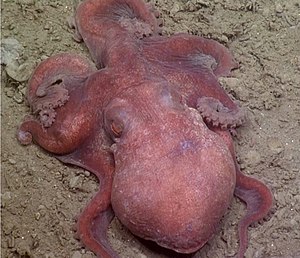California bigeye octopus
| California bigeye octopus | ||||||||||||
|---|---|---|---|---|---|---|---|---|---|---|---|---|

California bigeye octopus (Octopus californicus) |
||||||||||||
| Systematics | ||||||||||||
|
||||||||||||
| Scientific name | ||||||||||||
| Octopus californicus | ||||||||||||
| Berry , 1911 |
The California bigeye octopus ( Octopus californicus ) is a large cephalopods from the genus of octopus . He lives in the Pacific Ocean .
features
anatomy
Octopus californicus has a muscular body and a coat length of up to 14 centimeters. The average total length is 38 centimeters.
The arms are up to 30 centimeters long. They are usually 2.5 to 3.5 times as long as the coat. The outer limbs only reach half the length of the inner ones. Adult specimens form between 120 and 160 suction cups on each normal tentacle , which are arranged in two rows. In sexually mature males, 8-10 suction cups are enlarged on each arm, starting from the fourteenth proximal suction cup. In male specimens, the third right arm forms the hectocotylus . It is between 70 and 81% the length of a normal arm and has 46-53 suction cups. At the top there is a large conical ligula that can reach 10-22% of the arm's length. The calamus is tiny with around 2-6% of the length of the ligula . The velar skin is well developed and reaches up to 30% of the arm's length. It reaches deepest between the lateral arms. It is least developed between the dorsal and ventral pair. The edges of the velar skin are widened along the ventral side to the ends of the tentacles.
The gills have 12-13 lamellae per demibranch . The funnel organ has a VV-shaped appearance. The radula consists of nine elements, seven rows of teeth and marginal plates. The esophagus is swollen, but has no clearly protruding goiter. An ink sack and anal flaps are provided. The species has relatively large eyes for octopuses.
Appearance and camouflage
The back of the California bigeye octopus is uniformly orange-brown in color. The ventral surfaces of the mantle, head, and arms are paler in color. The eyelids are golden in color, often with a green iridophoric sheen. False eyespots ( ocelles ) are not present in this species.
The skin is covered with closely spaced, star-shaped spots, on each of which a raised, wart-shaped structure, a so-called papilla, grows. There is a large unbranched papilla over each eye.
Like all real octopuses, Octopus californicus can adapt its appearance to its surroundings. This camouflage is a combination of different chromatophores and a change in skin texture.
habitat
The California bigeye octopus lives in the northwestern Pacific . Its habitat extends from the Gulf of Alaska to the Mexican state of Baja California . This species occurs more rarely in the Sea of Okhotsk and the Sea of Japan .
Octopus californicus inhabits sand and mud habitats of cool waters at depths between 100 and 900 meters below sea level. This species occurs, among other things, in the hypoxic Santa Barbara basin, where it is able to regulate its oxygen consumption down to the limit of detectable oxygen partial pressure .
Reproduction
The spermatophores have a medium size and reach 70-80% of the mantle length. The elongated eggs are relatively large with a length of 17 millimeters. A female lays 100-500 of them, which are arranged in clusters and attached to a hard surface. The young that hatch from it are benthic , i.e. living on the ground.
Individual evidence
- ↑ a b c d octopus leader , Marc Norman (2000), Jahr Verlag GmbH & Co, ISBN 9783861325062
- ↑ a b c d e f g h CEPHALOPODS OF THE WORLD AN ANNOTATED AND ILLUSTRATED CATALOG OF CEPHALOPOD SPECIES KNOWN TO DATE (p. 194)
- ↑ Skin as superreflectors
- ↑ Octopodidae - Article at Tree of Life